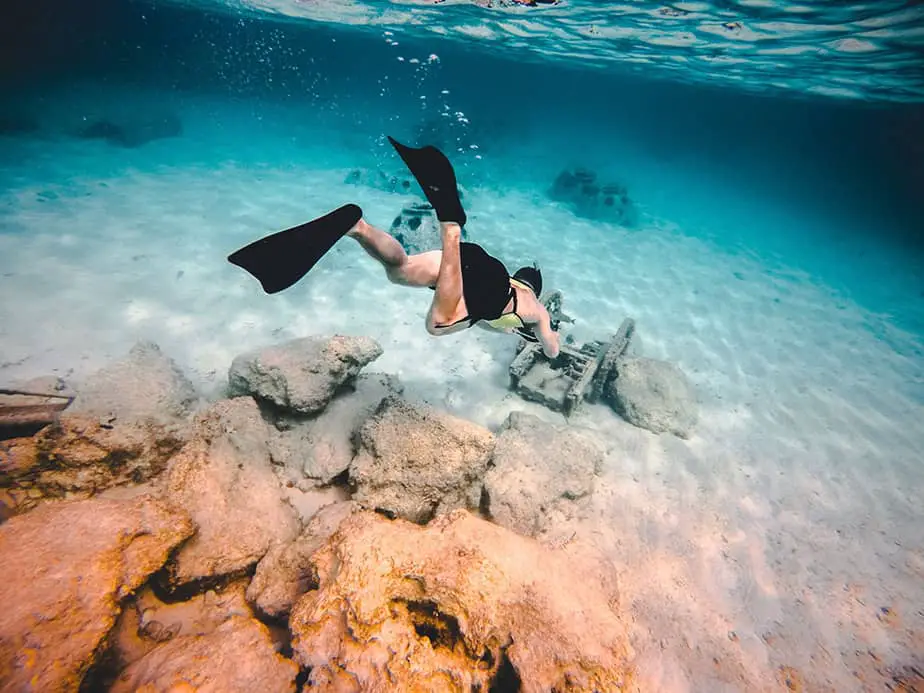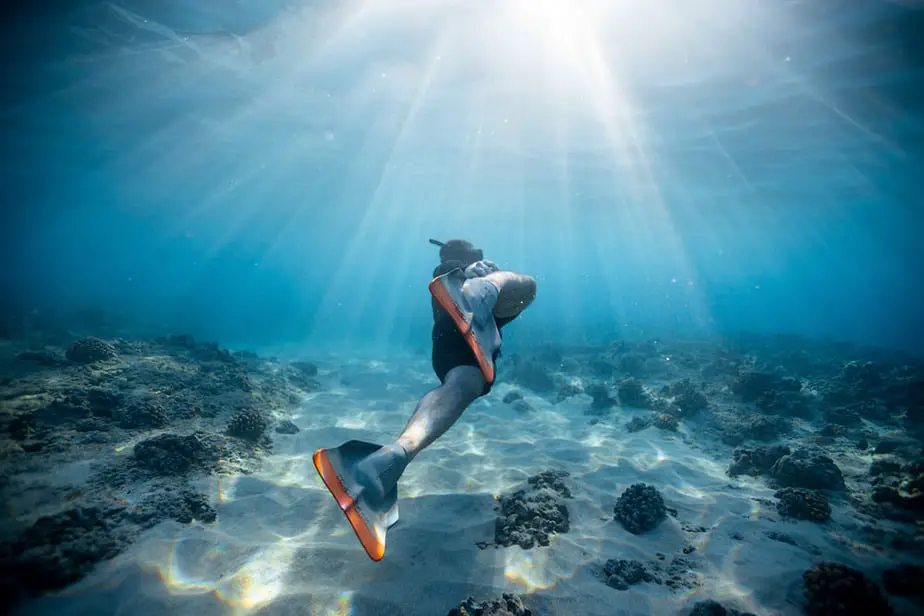So you’re deciding between getting short fins or long fins for your next snorkeling vacation, but the number of choices is making your head hurt. Thanks to the increasing popularity of snorkeling over the last couple of decades, many companies are making lots of equipment for this fun and accessible sport.
While this is great news overall, it means that beginner snorkelers have to do a lot more research into the different types of fins, such as open-heel or closed-heel, or in this case short fins vs. long fins. Some fins are only a few inches long, while others are more than a meter long. Which one should you pick for snorkeling?
First, let’s define what we consider a “short” or “long” fin. The most common distinction is what sport they are most often used for. Short fins are generally used for swimming and snorkeling and are typically shorter than 25 inches long. On the other hand, long fins are generally used for SCUBA diving and longer than 25 inches. There are fins that exceed 40 inches and these are used by spearfishes and freedivers.
Are Fins Necessary for Snorkeling?
No, technically you can snorkel without fins. All you need to snorkel are the snorkel and mask. However, wearing fins is encouraged for the many benefits they provide.
First, the additional surface area provided by fins lets you generate more thrust with each kick. This helps you travel farther and faster while using less energy. It will be easier for you to power through strong currents and waves with fins on.
Second, fins are slightly buoyant and will help you stay afloat. Snorkeling sessions are supposed to be relaxing and most of the time is spent floating. With fins, you won’t have to tread water to stay afloat. And if you suddenly get blindsided by some stray waves, you can easily reposition yourself and swim to safety.
Whether you are wearing short fins or long fins, you can make precise and deliberate movements underwater to help you avoid rock formations, coral, or other sea creatures.
If you are snorkeling in shallow waters, you may not need fins. However, with the amount of affordable short fins for travel on the market, you can easily pack it in your luggage and it won’t break the bank.
Short Fins vs. Long Fins Differences
Other than the length, what are the implications of getting a shorter or longer pair of fins? The crucial difference is thrust. Shorter fins are easier to kick with, but longer fins will generate more thrust at the cost of needing stronger kicks. Long fins are stiffer and harder to move around in, whereas short fins are flexible and easier to swim in.
What exactly is thrust? It is the forward force that is generated in response to each backwards kick you make. The stronger your kicks, the more thrust you generate. It also means you can move at greater speeds.
Whether you are wearing short fins or long fins, you can produce thrust. However, with longer kicks you can generate more thrust per kick, whereas with short fins on you must kick more. To put it in layman’s terms, longer fins push more water per kick.
This comes at a cost of requiring more power from your legs per kick, and people who don’t have strong legs or who have poor technique will struggle when using long fins. In other words, they would not get the benefits that long fins provide and are better off wearing short fins until they get stronger.
Usability
Thanks to its superior thrust efficiency, even a small kick with long fins on can propel you forward at great speeds. It takes a lot of skill to master how to move more precisely while underwater, so as not to disturb the sea creatures. It requires using more than the standard flutter kick.
Long fins are most commonly worn by SCUBA divers since they are bogged down by their heavy equipment and need as much thrust as possible to get moving. In order to get the most control over their movements, SCUBA divers need to master how to do the helicopter kick, reverse kick, and frog kick.
Short fins are a lot easier to work with due to their smaller size and how flexible they are. However, advanced divers are able to maneuver themselves while wearing long fins as well as if they were wearing short fins. It just requires more practice, and beginner divers and snorkelers may not be able to accomplish this.

Flexibility
Though there is no rule regarding how stiff a short or long fin should be, you can usually expect long fins to be stiffer.
Also, there is a degree of personal preference as well. You need to find fins that are just right for you. If it is too flexible, it will be easier to kick with but you won’t get very much thrust. Too stiff, and it requires significant leg power and won’t scoop water as efficiently.
In order to find this middleground, you should consider the blade length. Thanks to its extra surface area, long fins move more water and experience more resistance. A stiffer blade can withstand this resistance without bending too much. However, too stiff of a blade makes it inefficient. And if a long fin had the same flexibility as a short fin, its blade would be too floppy to generate any thrust.
Why Short Fins are Better (for Snorkeling)
Ease of Use
The reason why SCUBA divers have to put up with long fins is because they need them to generate more thrust with all of the gear weighing them down. Snorkelers aren’t burdened with heavy gear and can use shorter fins which are easier on their leg muscles.
Furthermore, snorkelers aren’t as concerned with swimming faster. They spend most of their time along the water’s surface relaxing and observing the underwater sea creatures. Moving around too much can cause the creatures they are observing to swim away. As such, lack of thrust is not a high priority for most snorkelers.
Additionally, short fins simply feel more natural to wear. They are small and you’ll quickly forget you’re even wearing them as you’re flutter kicking away. The rapid and short strokes of the flutter kick lends itself well to being used with short fins.
Great for Training
Train those leg muscles by practicing the flutter kick with short fins. Swimminers often wear short fins for this reason.
If you aren’t used to wearing fins, then first practice in the pool before going out to the ocean. You want to build up the strength and endurance in your legs first so that you can maximize your vacation time. Furthermore, you can build up the muscle memory to intuitively move around in the water with fins on. That way, you can spend more time in the water observing the beautiful sights in peace.
Many beginners make the mistake of kicking with just their knees and feet. The correct way to kick with fins starts with the hip. Just watch a video of a diver doing a flutter kick and take a look at their legs. It’s mostly straight, with the occasional bend in the knees. Try to keep your movements smooth and slow with flexed ankles. You should not be using your hands at all, which you should just let hang by your sides.
Perform Precise Movements Easily
People who are wearing fins for the first time often forget that their footspan is suddenly significantly longer with fins on. They may accidentally scrape their fins against coral, rocks, or other surfaces. With short fins, this is less likely to happen compared to long fins.
Also, as we mentioned above, short fins are easier to move around in. That means snorkelers wearing short fins or flippers are better at avoiding kicking wildlife, coral, rocks, or their snorkeling partners.
The shorter blade length also makes walking easier when entering and exiting the water from the beach. Divers wearing long fins will end up waddling awkwardly like penguins. That is why it is recommended that you shuffle backwards slowly into the water to prevent this.
Takes up Less Space
There’s a reason why some short fins are also marketed as travel fins. If you’re traveling by plane to your snorkeling destination, then packing fins that can easily fit into your luggage becomes a priority. You may want to get short fins that can fit inside a dry bag so that traveling to and from the snorkeling spot is more convenient. These short travel fins are slightly shorter than regular short fins at around 15-20 inches in length.
When Longer is Better
We alluded to the fact that an experienced snorkeler can use long fins to maneuver just as well as someone wearing short fins. If you ever reach this level of expertise, then in addition to snorkeling you can also do some freediving or SCUBA diving on the same trip wearing long fins.
You may want to look into a fin that is something like a hybrid of a pair of short fins or long fins. Something that is stiffer but still flexible, longer but still easy to move around in. In other words, you’ll need to look into getting a more flexible SCUBA fin that can also double as a snorkeling fin. That way, you will have the most versatility in how you want to spend your vacation.

